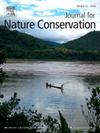Responses of black-headed gulls (Chroicocephalus ridibundus) to observers holding popguns: Adult and juvenile gulls differ
IF 2.2
3区 环境科学与生态学
Q2 BIODIVERSITY CONSERVATION
引用次数: 0
Abstract
Hunting is a way for humans to prey on animal life to satisfy their own interests, and animals constantly regulate their behavior to accommodate that type of predatory pressure. Despite the long-term bans on gun hunting and increasing species protection measures worldwide, few studies have focused on whether hunting history affects animal behavior, making the impact of hunting history on wildlife in urgent need of quantitative research. China’s long-standing policy of gun and hunting bans provides a unique opportunity to explore this issue. This study compared the flight initiation distance (FID) of black-headed gulls (Chroicocephalus ridibundus) overwintering in Kunming, Yunnan, southwestern China, with different ages (adult and juvenile gulls) by experimenters holding different types of handhelds. The results showed that adult and juvenile black-headed gulls were more fearful of the experimenter holding the “gun” as evidenced by longer FIDs; however, unlike adult gulls, juvenile gulls escaped later. This study showed that hunting activities can directly impact the behavior of birds, and hunting history can influence the antipredator behavior in birds.
黑头鸥(Chroicocephalus ridibundus)对观察者手持弹弓的反应:成鸥和幼鸥的差异
本文章由计算机程序翻译,如有差异,请以英文原文为准。
求助全文
约1分钟内获得全文
求助全文
来源期刊

Journal for Nature Conservation
环境科学-生态学
CiteScore
3.70
自引率
5.00%
发文量
151
审稿时长
7.9 weeks
期刊介绍:
The Journal for Nature Conservation addresses concepts, methods and techniques for nature conservation. This international and interdisciplinary journal encourages collaboration between scientists and practitioners, including the integration of biodiversity issues with social and economic concepts. Therefore, conceptual, technical and methodological papers, as well as reviews, research papers, and short communications are welcomed from a wide range of disciplines, including theoretical ecology, landscape ecology, restoration ecology, ecological modelling, and others, provided that there is a clear connection and immediate relevance to nature conservation.
Manuscripts without any immediate conservation context, such as inventories, distribution modelling, genetic studies, animal behaviour, plant physiology, will not be considered for this journal; though such data may be useful for conservationists and managers in the future, this is outside of the current scope of the journal.
 求助内容:
求助内容: 应助结果提醒方式:
应助结果提醒方式:


